Physical Address
304 North Cardinal St.
Dorchester Center, MA 02124
The oldest known illustration of compression bandages dates back to the Neolithic Age (5000–2500 bc ) ( Fig. 6.1 ). The ancient Hebrews, Egyptians, Greeks and Romans used compression therapy for treatment of wounds and ulcers, as described in the Smith Papyrus (1650–1552 bc ) and in the Book of Isaiah (Isaiah 1 : 6), eighth century bc . Hippocrates wrote about compression treatment in the fourth century bc , and this was followed by further refinements from Celsus and Virgo. Roman soldiers who marched for days at a time quickly learned that applying tight strappings to the legs reduced leg fatigue. The knowledge concerning the beneficial effects of compression was rediscovered by physicians during the Middle Ages, including Guy de Chauliac (1363), Giovanni Michele Savonarola (1440) and Fabrizio d'Aquapendente (1537–1619). They used compression bandages, plaster dressings and laced stockings made from dog leather.
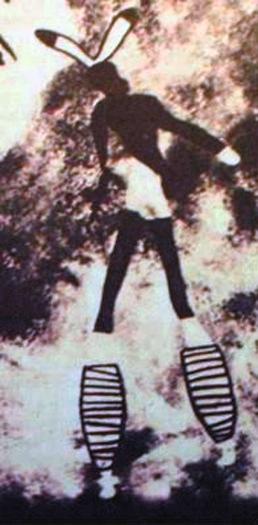
Ambroise Paré (1510–1590), Richard Wiseman (1622–1676), Christian Anton Theden (1714–1787) and Thomas Baynton (1797) were pioneers, especially in the treatment of leg ulcers, who recommended different kinds of compression material that were mainly inelastic. In 1885, the dermatologist Paul Unna introduced his zinc paste boot for the treatment of venous dermatitis, and in 1910 his pupil, Heinrich Fischer, recommended firmly applied ‘Unna boots’ for treating venous thrombosis.
The use of elastic compression occurred with the development of elastic stockings in the mid 1800s and the discovery by Charles Goodyear in 1839 of a vulcanizing process for rubber that would increase its elasticity and durability. In 1839, John Watson, MD, reported on the usefulness of an elastic stocking in treating varicose veins in a 23-year-old woman with Klippel–Trenaunay syndrome. However, these stockings, made exclusively from rubber threads, were uncomfortable. It was not until Jonathan Sparks patented a method for winding cotton and silk around the rubber threads that elastic stockings became comfortable and popular.
During the late 1800s and early 1900s, technical advances in the manufacturing process led from the development of the frame-knitting to the flat-knitting method, which increased production efficiency in addition to providing a proper fit. Stockings became even more comfortable and better looking when ultra-fine rounded latex yarns became available, which permitted the construction of seamless stockings. Two-way stretch stockings were developed next, which led to easier application of the stocking. Finally, the development of synthetic elastomers in the 1960s gave rise to latex-free compression stockings. Synthetic (spandex, polyurethane and nylon) stockings are still the ideal form of material to use today because of the relative resistance to moisture from sweat and other environmental factors and also the very fine threads and stretch–contraction characteristics that lead to the production of fine stockings.
Today there are more than 200 different brands of graduated compression stockings. As a complete discussion comparing all of the available stockings is beyond the scope of this chapter, concepts are discussed that are central to all forms of compression stockings, and information is given on the more commonly used and available brands.
By increasing the tissue pressure, compression works against filtration, which is the basis of both prevention and removal of edema. Occupational leg swelling in sitting and standing professions can be prevented by light compression stockings, which are also able to reduce mild edema. Reduction in intradermal edema has been measured with 20-MHz ultrasound in patients with chronic venous insufficiency (CVI) and lipodermatosclerosis. Application of class I or II graduated compression stockings decreased dermal edema by 17% in 4 days with no statistical difference between the two classes of compression. It could be demonstrated that stockings with a pressure of about 20 mmHg are quite effective in reducing leg edema and that this effect can be maintained by donning a second stocking over the first.
Compression may also exert beneficial effects in nonphlebologic causes of edema, such as inflammatory edema (arthritis, cellulitis), cardiac edema, dysproteinemic edema, renal edema, lymphedema and cyclic idiopathic edema. A study by Arpaia et al showed an improvement in the quality of life (QOL) in patients with chronic CVI who wore class I graduated compression stockings.
Several beneficial mechanisms of compression therapy on the swollen extremity may be explained by its effects on the lymphatic system :
Reduction of capillary filtration
Increase of capillary reabsorption
Shift of fluid into noncompressed parts of the body
Increase of lymphatic reabsorption and lymphatic transport
Breakdown of fibrosclerotic tissue
Down regulation of proinflammatory cytokines and receptors for growth factors
One mechanism of central importance is the restriction of capillary filtration, which corresponds to the amount of the lymphatic load. With compression, the skin and dermal tissues are in closer contact with the superficial capillary network, which is otherwise separated by a pericapillary halo of protein-rich edema fluid.
Compression removes more water than protein from the tissue, thereby increasing oncotic tissue pressure and reinforcing the need for sustained compression. Therefore, in chronic edema, success is dependent on continued compression.
Compression together with movement enhances the contraction of the lymphatic system. Olszewski was able to demonstrate that both compression and exercise stimulated the movement of stagnating lymph through the lymph collector in lymphedema patients whose lymphatic trunks were filled. This is probably one explanation for the reduction in intralymphatic hypertension obtained by complex decongestive therapy as demonstrated by Franzeck and co-workers by lymph capillary pressure measurements.
Intermittent pneumatic compression enhances prefascial lymph drainage. Unna boots are able to increase subfascial lymph transport, which is reduced in postthrombotic syndrome. Consequent compression leads to a morphologic improvement of pathologic initial lymphatics in patients with lipodermatosclerosis, which can be demonstrated by indirect x-ray lymphography ( Fig. 6.2 ).
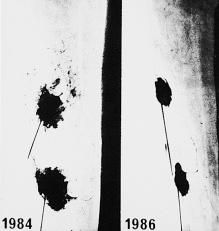
Depending on the exerted pressure and the body position, external compression is able to narrow or occlude superficial and deep leg veins. In the supine position an external pressure of 10 to 15 mmHg is enough to decrease the venous diameter. This results in an increase in blood flow velocity as shown by measuring the circulation time with isotopes, and is the rationale for recommending light compression stockings for thromboprophylaxis in bedridden patients. A graduation in pressure (18 mmHg at the ankle, falling to 8 mmHg at the thigh) leads to a significantly increased velocity in the deep femoral vein flow.
In the upright position, such low pressure will have only a minimal effect on decreasing the diameter of the leg veins. However, a very small decrease of venous diameter will result in an over-proportional decrease of the local blood volume as demonstrated by several plethysmographic studies. Stockings with an ankle pressure of around 20 mmHg have been shown to improve the venous pump. Elastic compression stockings with low pressure have also been found to significantly reduce symptoms of CVI in patients during daily work activity.
Bandages may provide much higher pressure in the upright position. Magnetic resonance imaging (MRI) is able to show that during standing deep veins will be narrowed by an external pressure of 42 mmHg and nearly occluded by a pressure of 82 mmHg ( Fig. 6.3 ). During ankle movements and walking with stiff bandages, pressure peaks of this magnitude will lead to an intermittent occlusion of the veins ( Fig. 6.4 ). Such high pressure may be tolerated only with inelastic (not with elastic) material.

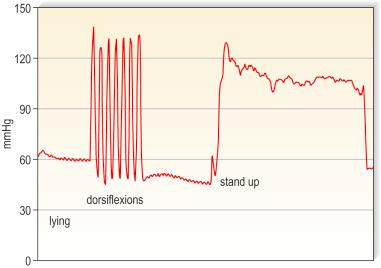
The compression pressure when starting to walk counteracts the lateral expansion and dilation of leg veins during muscle contraction by encasing the veins in a semirigid envelope.
The application of an external pressure with a blood pressure cuff blown up to 40 to 60 mmHg to various portions of the leg containing incompetent valves led to an abolishment of reflux. This effect was directly associated with a decreased vein diameter. Reduction of venous refluxes and improvement of ambulatory venous hypertension by external compression could be demonstrated even in patients without any valves (avalvulia), indicating that this effect is not necessarily explained by coaptation of distended valve leaflets, but rather seems to be owing to increasing the resistance to retrograde flow. Increasing external pressure in the upright position increases the ejection fraction of the calf muscle pump function.
Conflicting results have been reported concerning an improvement in ambulatory venous hypertension by using compression stockings. One study showed a significant decrease of such hypertension with short-stretch bandages applied with a resting pressure on the distal leg of more than 50 mmHg, but no decrease with elastic compression stockings exerting a pressure of 30 to 40 mmHg. This may be explained by the fact that inelastic short-stretch bandages lead to an intermittent short venous occlusion during the muscle systole while walking. In patients with venous ulcers resulting from deep venous incompetence, short-stretch bandages are able to impede venous reflux more effectively than are elastic stockings exerting the same resting pressure. Patients with severe stages of CVI benefit more from high compression pressure, whereas lower pressure is sufficient for milder stages such as varicose veins.
The key mechanism of compression therapy to reduce ambulatory venous hypertension in patients with severe CVI is an intermittent occlusion of the veins during walking. In contrast, continuous obliteration of veins by external compression may be desirable after varicose vein surgery to stop bleeding and after sclerotherapy to prevent refilling of blood.
To achieve complete occlusion of superficial veins the external pressure should be higher than the intravenous pressure, and this depends on the body position. It was shown that occlusion of the leg veins can be obtained with an external pressure in the range of 20 mmHg in the supine position, but that in the sitting and standing positions the pressure has to be between 50 and 70 mmHg. With compression stockings, such pressure ranges can only be achieved when rolls or pads are applied over the vein, thereby increasing the local pressure by reducing the local radius (law of Laplace, see later). Such rolls may be especially useful if local compression over treated veins on the thigh is intended.
Compression accelerates blood flow in the enlarged capillary loops and reduces capillary filtration because of enhanced tissue pressure. Improvements are seen in normalization of venular flow, volume and velocity, improved distribution of microcirculation blood flow and normalization of leukocyte adhesion. Different studies using electron microscopy were able to show a restoration of the structural changes in the media myocytes in stripped veins and a tightening of intercellular junctions. Laser Doppler flux measured a 29% increase in blood cell velocity in patients with CVI and lipodermatosclerosis. Even in patients with mixed arterial–venous ulcers an increase of laser Doppler fluxmetry could be demonstrated up to a compression pressure of 40 mmHg. Increasing flow velocity may reduce the likelihood of white blood cells interacting or sticking to endothelium with release of various factors. Effects on mediators involved in the local inflammatory response may explain both the immediate pain relief that occurs with good compression and ulcer healing. Studies in patients wearing class II graduated compression stockings demonstrate an improvement in skin microcirculation in as little as 1 week, with near normalization of the functional state of microcirculation becoming apparent by day 30. Model experiments with intermittent pneumatic compression were able to demonstrate that there is an increased release of the endothelial relaxing factor (EDRF) nitrogen oxide from the endothelial cells, depending on the amount of shear stress produced by the compression waves. Compression tightens the junctions between the endothelial cells of capillaries and reduces proinflammatory cytokines in venous leg ulcers.
A reduction in arterial flow may be expected when the external compression pressure exceeds the intraarterial pressure. This may happen in patients with arterial occlusive disease with a reduced peripheral arterial pressure. To avoid ischemic skin lesions from external compression, it is essential to measure the peripheral arterial pressure using a Doppler probe before strong compression bandages or stockings are applied. It is generally accepted that a Doppler ankle–brachial index (ABPI) of less than 0.5 is a contraindication for sustained compression. However, external compression does not invariably mean reduction of arterial flow. Mayrovitz reported on several experiments concerning arterial blood flow and compression, and was able to demonstrate an increase of the pulsatile flow below the knee in healthy volunteers using nuclear magnetic resonance flowmetry. He also demonstrated a reduction in toe blood perfusion, which was greater with increased compression, but not of sub-bandage skin perfusion.
Patients with edematous legs and with an ABPI of between 0.5 and 0.8 may benefit from inelastic or short-stretch bandages applied with a mild resting pressure, because of the edema-removing massage effect that will occur with every ankle movement (see later). Completely inelastic bandages together with walking have a similar effect as intermittent pneumatic compression. The rhythmic pressure peaks of an inelastic bandage during walking can be compared with those exerted by an intermittent pneumatic pressure pump. Several experiments with intermittent pneumatic compression have demonstrated an increase of arterial flow in patients with arterial occlusive disease. The decisive mechanisms of action are the reduction of edema, an increase of the arteriovenous pressure gradient, myogenic mechanisms and the release of vasoactive substances from the endothelial cells. Especially during walking with inelastic bandages the increase of the ejection fraction of the venous calf pump may considerably contribute to an increase of arterial blood flow.
A confusing variety of partly overlapping terms can be found in the literature. Only terms of practical importance are listed here:
Elasticity: Capability of a strained body to recover its size and shape after deformation.
Extensibility: Maximum degree, expressed as a percentage of the unloaded size of the compression material to which it can be stretched in the circumferential or longitudinal direction.
Hysteresis: A measure of the energy loss that occurs between loading (stretching) and unloading (relaxing) (see Fig. 6.10 ). Yarns with minimal hysteresis are best because they have maximum holding power with minimum stretch resistance.
Stiffness: Increase in compression per centimeter increase in the circumference of the leg, expressed in hectopascals per centimeter and/or millimeters of mercury per centimeter. Using in vitro testing, this definition applies also to the ‘slope value’.
Static stiffness index: Difference between standing and lying interface pressure measured in vivo at the transition between the muscular and tendinous parts of the medial gastrocnemius muscle (‘B1 point’). Figure 6.5 shows an example.
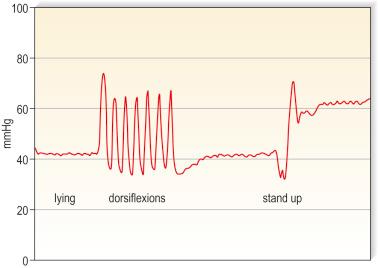
Dynamic stiffness index: Difference between maximal peak pressure and resting pressure measured in vivo.
Resting pressure: Pressure from the compression device itself with the muscles at rest.
Working pressure: Pressure coming from inside the device, originating from contracting muscles.
Pressure amplitudes: Difference between maximal and minimal pressure fluctuations during exercise, characterizing the ‘massaging effect’ of the compression device.
Pressure profile, pressure gradient: Representation of the compression exerted by the device along the leg.
Residual pressure: Compression at a certain point expressed as a percentage of the compression at the ankle.
The compression pressure (Pascal) is defined by the force (Newton) that is exerted to an area of 1 m 2 ( Fig. 6.6 ). The tension in a bandage is determined by the force applied to the fabric during application.
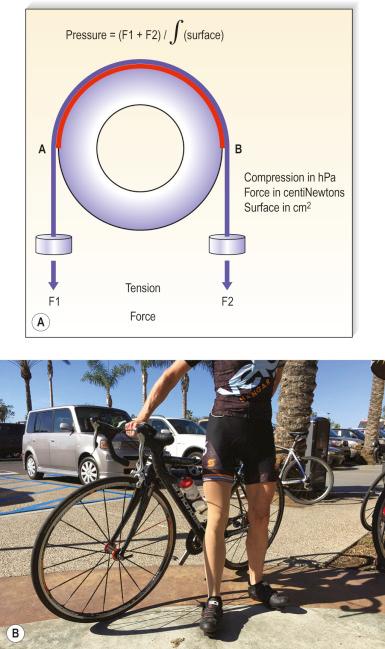
The unit for pressure is 1 Pascal (Pa), which is 1 Newton (N) per square meter. In the medical field, for example measuring blood pressure, the usual unit for pressure is the weight of one cubic millimeter of mercury: 1 mmHg = 133,332 Pa = 1333 hPa
From Figure 6.6 , it is clear that the curvature of the leg plays a deciding role for the exerted pressure. If the cylinder in the model was replaced by a cube, the pressure over the flat areas would be zero, whereas it would be very high along the sharp edges of the cube. This is described by Laplace's law stating that the pressure ( P ) is directly proportional to the tension ( T ) of the bandage, but inversely proportional to the radius ( R ) of the curvature to which it is applied ( Fig. 6.7 ):
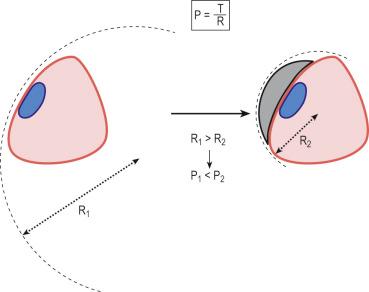
P decreases as R increases. When R is going to be indefinite such as over the flat areas of a cube, P will become zero.
In general, pressure is calculated for the circumference of the limb at a specific level. Because the leg has an irregular cross section that is not circular, the applied point pressures vary at different locations around the leg. Using Laplace's formula, it is evident that the effective pressure is greatest at the point of minimum radius and least at the point of maximum radius. Thus when a stocking is applied, the anterior aspect of the leg receives the greatest amount of pressure, and the lateral and medial sides of the leg receive the least compression pressure. This is especially important in the malleolar area, where the lowest degree of compression occurs, because the medial and lateral surfaces are flat or concave and the local radius is ‘negative’ ( Fig. 6.8 ). If there is a venous ulcer situated in the dip behind the malleolus, the only way to bring compression to this region is to put a pad over that area ( Fig. 6.9 ). The reduction of the local radius by pads or rolls in order to increase local pressure has been termed ‘positive eccentric compression’.
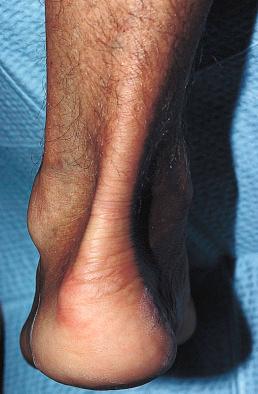
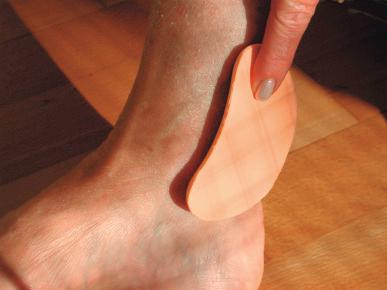
On the other hand, tendons and bony prominences are susceptible to a high compression pressure and should therefore be protected under a bandage by decreasing the radius using a cotton wool inlay. The enlargement of the local radius has been termed ‘negative eccentric compression’.
It is obvious from Laplace's law that a very thick leg requires more tension to achieve the optimum cutaneous and subcutaneous pressures, whereas a thin leg should be wrapped with a much lower tension.
The effects of compression depend widely on the exerted pressure, which should be adapted to the underlying condition. Basically the pressure of a stocking is calculated from the force–extension diagram of the elastic fabric on a wooden leg model with defined circular cross sections using Laplace's formula ( Fig. 6.10 ). The range of the compression pressure indicated by the manufacturers is determined by the measurement of the force necessary to stretch the stocking at certain leg levels (B, B1, C, D, F, G) in a transverse direction. The proportion of stretch and force for each circumference level, which corresponds to the steepness of the so-called slope in the hysteresis curve, reflects the elasticity of the material of the stocking.
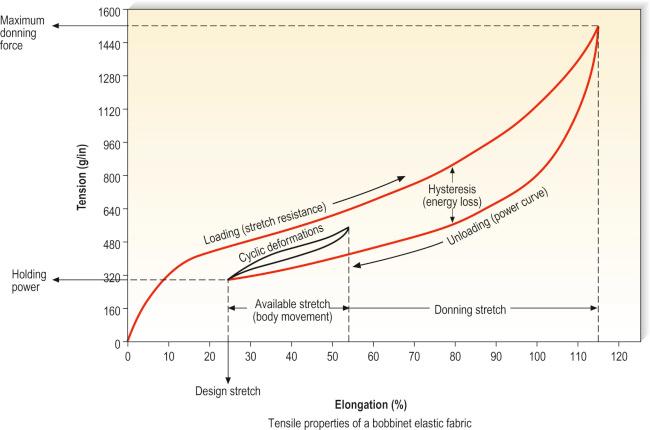
Several industrial measuring systems for obtaining hysteresis curves are used, such as the Hosy method, the Hatra tester, the Instron method, the French ITF method and others.
Measuring points, lengths and girths defined by the European standardization proposal (CEN, Centre Européen de Normalisation) are shown in Figure 6.11 .
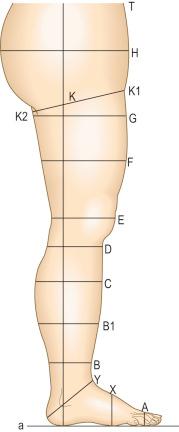
Table 6.1 gives a comparison of compression classes for ready-to-wear and custom stockings used in several countries. The range of compression pressures and also the verbal description of these classes are amazingly variable from one country to another. Additionally, it is important to realize that the given ranges are measured by different methods and so comparisons are problematic. These facts underline the necessity of in vivo pressure measurements on the individual leg in future clinical studies. For a better universal understanding, it is recommended using the pressure range in mmHg rather than compression classes in general.
| Compression Class | EU (CEN) | USA | UK (BS 6612) | France | Germany |
|---|---|---|---|---|---|
| A | 10–14 (light) | ||||
| I | 15–21 (mild) | 15–20 (moderate) | 14–17 (light) | 10–15 | 18–21 (light) |
| II | 23–32 (moderate) | 20–30 (firm) | 18–24 (medium) | 15–20 | 23–32 (medium) |
| III | 34–46 (strong) | 30–40 (extra firm) | 25–35 (strong) | 20–36 | 34–46 (strong) |
| IV | >49 (very strong) | 40+ | >36 | >49 (very strong) |
The pressure values in Table 6.1 refer to level B. The European prestandard defines the ranges of pressure profiles in comparison with the pressure at the smallest leg circumference (position B) as follows: for level B1 70% to 100%, for C and D 50% to 80%, and for F and G 20% to 40% for compression classes III and IV; 20% to 60% for compression classes A and I, and 20% to 50% for compression class II ( Fig. 6.12 ). The producers of compression stockings recommend adjusting the compression class according to the clinical severity.
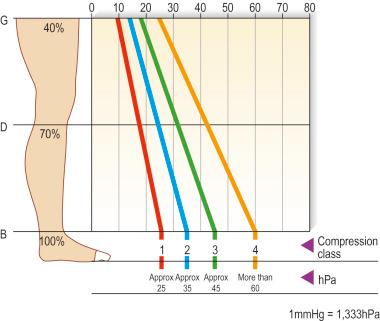
There is no American standard. Table 6.2 gives an example as recommended by one company (BSN-Jobst, Charlotte, NC).
| 8–15 mmHg | 15–20 mmHg | 20–30 mmHg | 30–40 mmHg | 40+ mmHg |
|---|---|---|---|---|
| Tired, aching legs | Minor varicosities | Moderate to severe varicosities | Severe varicosities | Severe varicosities |
| Minor ankle, leg and foot swelling | Minor varicosities during pregnancy | Postsurgical | Severe edema | Severe edema |
| Tired, aching legs | Moderate edema | Lymphatic edema | Lymphatic edema | |
| Minor ankle, leg and foot swelling | Postsclerotherapy | Management of active venous ulcerations | Management of active venous ulcerations | |
| Postsclerotherapy | Helps prevent recurrence of venous ulcerations | Helps prevent recurrence of venous ulcerations | Manage manifestations of PTS | |
| Helps prevent DVT | Moderate to severe varicosities during pregnancy | Manage manifestations of PTS | Orthostatic hypotension | |
| Superficial thrombophlebitis | Helps prevent PTS | Postphlebitic syndrome | ||
| Helps prevent DVT | Orthostatic hypotension | CVI | ||
| Postsurgical | ||||
| Postsclerotherapy | ||||
| Helps prevent DVT | ||||
| CVI |
Compression therapy is a very effective treatment tool for which the ‘dosage’, that is the pressure on the individual leg, has been completely underestimated up to now. At least for clinical trials comparing different compression products, we need to measure the interface pressure on the individual leg and not just rely on the specifications of the producers. This is true not only for compression stockings whose pressure range is measured by different laboratory methods, making a comparison in treated patients problematic, but even more so for compression bandages. The pressure exerted by a compression bandage depends completely on the skill and experience of the bandager and only single standards are available that are far away from clinical practice.
Several instruments are available, which should be calibrated on the leg according to a recent consensus recommendation. In this consensus paper, some prerequisites of an ‘ideal’ pressure sensor are summarized. One location that should always be included in future pressure measurements is B1. This is where the tendinous part of the gastrocnemius muscle changes into the muscular part, showing the most pronounced protrusion of the tendon and the most extensive enlargement of the leg circumference during dorsiflexion or by standing up from the supine position. Whenever in vivo measurements of interface pressure are performed, it is essential to indicate the exact measuring point, the main specifications of the instrument, including the dimensions of the probe, and the body position in which the measurements have been performed. Figure 6.13 shows a pressure measuring instrument that allows continuous pressure registration. The flat probe is inflated only when pressure is measured and can stay on the leg for several days. Figures 6.4 and 6.5 show pressure curves obtained with this instrument.
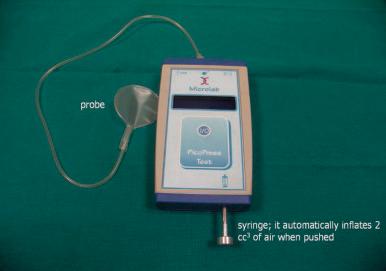
Some probes allow measurements of interface pressure not only at rest but also continuously during movement. Figure 6.14 shows an example where the interface pressure on the distal leg was measured continuously in different body positions, both for an inelastic and for an elastic bandage. Starting with comparable resting pressure for both bandages, the inelastic bandage has a higher working pressure than the elastic bandage. This difference has a major impact on the efficacy of the compression device concerning edema reduction and improvement of venous pump. Stockings with high stiffness or slope value, even at the same compression level, are better for patients with edema from CVI or other causes. Inelastic bandages are more effective to reduce venous reflux and ambulatory venous hypertension.
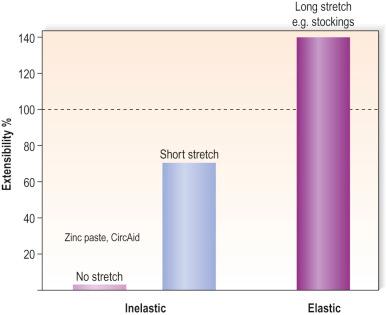
Measurements of intramuscular pressure have shown higher resting pressure with elastic than with inelastic material, suggesting that elastic compression applied over a long period in the recumbent posture may impede microcirculation and jeopardize tissue viability.
Stiffness is defined as the increase in compression per centimeter increase in the circumference of the leg, expressed in millimeters of mercury per centimeter. This parameter characterizes the distensibility of a textile in addition to the elastic property of a composite bandage, which plays an important role concerning the performance of a compression device during standing and walking. Stiffness may be measured in the laboratory, where it corresponds to the slope of the hysteresis curve. The fact that it can also be assessed by in vivo measurements on the individual leg will certainly achieve increasing practical importance in future trials.
Measurement of dynamic stiffness during walking requires sophisticated instrumentation and can therefore not be used in routine clinical practice. To obtain valuable information about the elastic property of a compression device, which may be quite complex when several materials are combined, the so-called ‘static stiffness index (SSI)’ may be a useful alternative. A calibrated pressure sensor is fixed to the medial aspect of the leg at B1. This is the area that will show the most extensive changes in local curvature and leg circumference when the body position is changed between supine and standing. The difference between the interface pressure in the standing and in the lying position, called SSI, is a valuable parameter for the stiffness of the compression system that determines the relationship between resting and working pressure. As is shown in Figure 6.15 , inelastic material produces a much higher pressure increase in the upright position than elastic material. It is important to note that different indices may be obtained with different sensors. Therefore reliable comparisons of different compression devices will only be possible by testing using the same sensor on the same site.

It has been shown that different padding materials may change the stiffness of the final bandage.
Different devices/materials are available for compression therapy ( Box 6.1 ). The main categories of compression concerning the elastic properties of the materials are summarized in Table 6.3 . Extensibility is the ability of a bandage to increase in length in response to an applied force.
Ready-made ‘off the shelf’ stockings manufactured in fixed sizes
Made-to-measure stockings, custom-made according to the length and the circumference of the leg
Below-knee hosiery
Mid-thigh hosiery
Thigh hosiery
Single-leg panty
Panty hosiery
Inelastic
No stretch (extensibility close to zero)
Short stretch (extensibility <100%)
Elastic
Long stretch (extensibility >100%)
‘Nonadhesive’, cohesive, adhesive
Single component
Multiple components
Become a Clinical Tree membership for Full access and enjoy Unlimited articles
If you are a member. Log in here